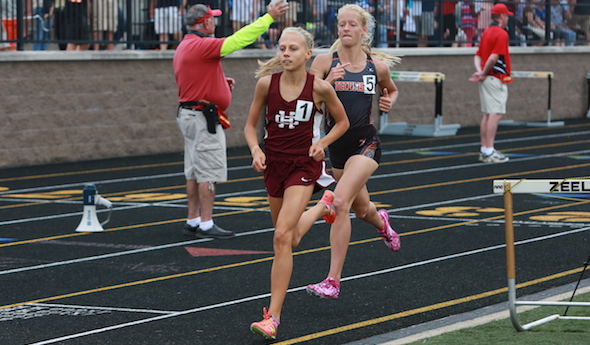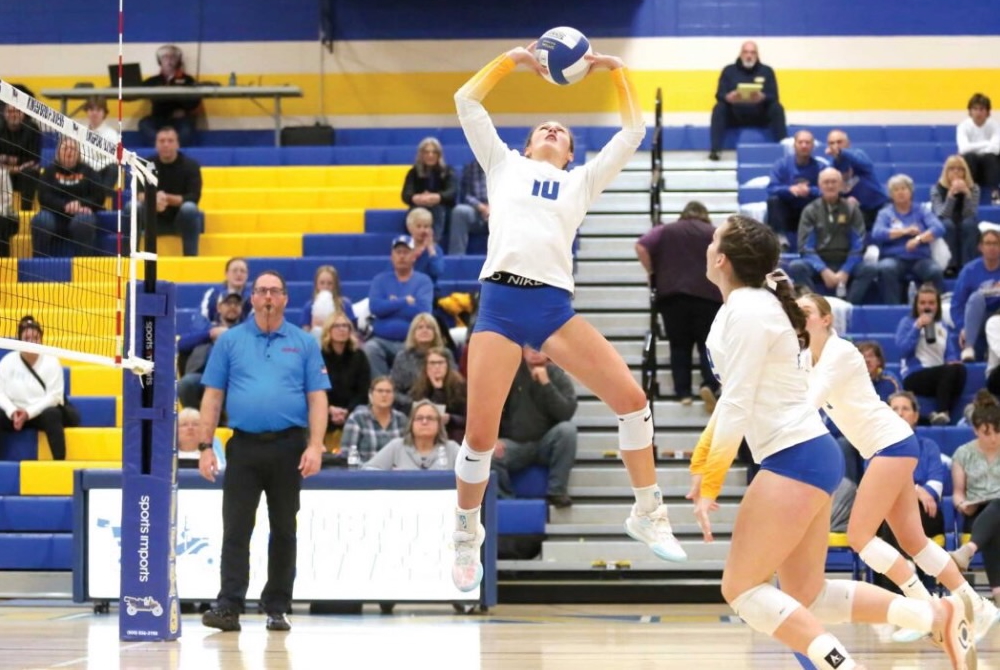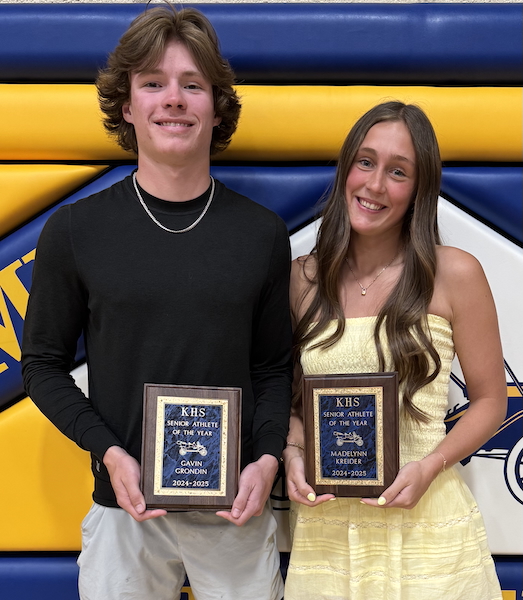
Inspiration Fuels Windemuller's Pursuit
By
Tom Markowski
Special for Second Half
June 3, 2017
ZEELAND – It hasn’t been easy at Holland Christian this school year. Certainly not as easy as Kayla Windemuller made it look on the track Saturday.
Windemuller pulled off a rare triple as the junior defended her titles in the 1,600 and 3,200-meter runs and ran anchor on the winning 3,200 relay (9:09.41) at the Lower Peninsula Division 2 Track & Field Finals at Zeeland.
Five people associated with Holland Christian schools died this school year. One was a 13-year-old girl and two were teachers, and it’s something Windemuller and everyone associated with the schools can’t forget.
“It’s tough at the school,” Windemuller said. “In some meets during the season it’s tough to run. When I run in those I think of them. They inspire me. I run for them.”
Windemuller is an inspiration to any young runner, distance or otherwise. She set a personal record in the mile (4:52.60) and, although she came up short of her goal in the 3,200 run (10:49.90), it was a day to savor.
“I was concerned about the heat, but it didn’t affect me too much,” she said. “It’s amazing to defend my title(s). I really like (running) the two mile. I’m more of a distance girl.
‘My goal was to get under 10:40. At the start I felt pretty good. That’s OK. I ran a PR in the mile. It is a long day, but it’s nice to have the meet spaced out. We run the relay in the morning, and then the races get slower as the day goes on. The day, overall, was awesome. I’m not happy with the times. The three state titles are sweet.”
Team title No. 2
Lansing Waverly competed well but luck also played a part in its second consecutive title.
Waverly had no individual winners, but did place first in two relays (400 and 800) to win with 47 points. Zeeland East was second with 46, and Holland Christian was third with 34.
Here’s how some of the drama played out.
Due to injuries Waverly coach Rex Wilkes, Jr., had to shuffle his lineup on the relays. The Warriors had the fastest time in the division in the 1,600 relay entering the Finals, but Wilkes made the decision not to compete in the event while attempting to save his top runners for other races.
It worked, but just barely.
“I knew we could score around 50 (points),” he said. “I just didn’t know what the other teams would do. We got some extra points in the shot. We got 10 there. And then I was told that Priscilla (Trainor) had to finish third or higher in the 200 for us to win.”
Trainor finished third. That’s not all. Suenomi Norinh of Zeeland East finished tied for first in the 100 hurdles with times measured out to hundredths of a second; to break the tie, it was determined she finished second by two thousandths of a second.
“Sometimes it’s good to be great,” Wilkes said. “Sometimes it’s good to be lucky.”
Norinh, a junior, did take first in the high jump (5-foot-8) and was second in the long jump.
Double winner
Liz Pyles of Cadillac placed third in both the discus and shot put last season as a junior, and she took that experience to place first in the shot with a put of 45 feet, 4 inches, a personal best, and won the discus with a throw of 146-3.
“I’m so happy,” she said. “I had three new PRs today (in the shot put). I’m so pleased.
“Last year was something to build upon. I worked with my coach. I worked in the weight room. I went to a bunch of camps. I’m real serious about this.”
Pyles signed with Grand Valley State University and expects to compete in both events. She qualified for the MHSAA Finals in the shot put all four seasons and the discus three times. Even so, she doesn’t have a favorite.
“It depends on the season,” she said.
Catching up quickly
Zoe Eby of Carleton Airport is a notorious slow starter. And when you’re competing in the 100 dash, that usually doesn’t bode well.
Eby got off to a poor start again but managed to come back to win the race with a time of 12.11.
“The last 30 meters was really close,” she said. “When I got off to that start I thought I would (finish) in the middle of the pack. I honestly don’t know how I did it.”
Eby, a junior, also defended her title in the 200. As a freshman she won the 400. She doesn’t compete in that event anymore.
“It’s not my niche,” she said.
Switching gears
Jakarri Alven of Grand Rapids Catholic Central wasn’t at her best Saturday. She said she had to pull out of the 200 because she was feeling ill.
Nevertheless, she won the 400 (56.48), a race she also won last year as a freshman, and she ran anchor on the winning 1,600 relay.
“I’m better at the longer distances,” she said. “But I like the (200). I got off to a good start today (in the 400). It’s the longer distances that I can work through better. I guess I’m better at it.”
Waiting pays off
Waiting for the other competitors to complete their jumps in the long jump was getting to Taylor Dziatczak of Macomb Lutheran North. Dziatczak had used up her tries and stood in first place with a jump of 17 feet, 11½ inches.
“It was a nail-biter,” she said. “A couple of girls who were close had a couple more jumps left. The girl from Zeeland East (Norinh) had three more left. I had to go to some deep breathing to stay calm.”
Dziatczak, who placed second last year, did hold on for first.
The long jump isn’t her best event, and it’s really not second as far as favorites. The javelin is tops with her. Dziatczak is a two-time AAU All-American in the javelin and has signed with Ashland University in Ohio to compete in the heptathlon. That’s seven events, in case you’re wondering. She placed in the javelin as a sophomore nationally in her age group and was third this year. Dziatczak, who is 17 years old, pointed out she moved up to the 18-and-under age group this year.
She just started competing in the heptathlon two years ago.
Her second favorite event is the 200 dash. The other events are the 100 hurdles, 800 run, high jump and shot put.
“I ran. I jumped. I figured why not do all of the others?” she said.
Why not indeed.
Record vaulter
Spring Lake senior Gabriella LeRoux set the only meet record in Lower Peninsula Division 2 for this season, pole vaulting 12 feet, 6 inches to break Kristen Hixson's mark of 12-4 set in 2010 while competing for Remus Chippewa Hills.
LeRoux's best this season heading into the meet was 12-0. A junior, she also won the pole vault championship in 2016 and was second in 2015 to her older sister Allie.
PHOTO: Holland Christian's Kayla Windemuller stays a pace ahead of Tecumseh's Christina Sawyer during one of their two races against each other Saturday. (Photo by Janina Pollatz/RunMichigan.com.)

Kingsford's Kreider Prepared for Next Level After Finishing Stellar Flivvers Career
By
John Vrancic
Special for MHSAA.com
June 19, 2025
KINGSFORD — After completing a successful high school volleyball career, Maddy Kreider is ready to take the next step.
 The Kingsford senior is taking her talents to Michigan Tech, where she’s expected to continue primarily as a setter.
The Kingsford senior is taking her talents to Michigan Tech, where she’s expected to continue primarily as a setter.
“That will be a big step for sure, but it’ll be exciting being with the girls,” she said. “The girls are taller in college. It will definitely be an adjustment, physically and mentally. We’ll be traveling longer distances, and it’ll be a matter of improving the mental part of my game.”
Kreider was selected the Upper Peninsula’s Defensive Player of the Year her final two seasons after the U.P. Sportswriters and Sportscasters Association began voting for all-U.P. volleyball.
“That’s quite an accomplishment,” she said. “It’s a real honor playing with girls I grew up with. We had a great season.”
The 5-foot-8 setter was a four-year starter and two-year team captain at Kingsford, leading the Flivvers to three Division 2 District titles and back-to-back undefeated Great Northern Conference championships. She twice was named GNC Player of the Year.
She was also selected all-state first team in the fall and all-state second team in 2023, and all-region throughout her prep career. Her serving percentage also topped .900 throughout her four seasons on varsity.
 Last fall, the Flivvers reached the Regional Semifinal at Manistique where they dropped a 3-2 decision to Kingsley.
Last fall, the Flivvers reached the Regional Semifinal at Manistique where they dropped a 3-2 decision to Kingsley.
“I thought we’d get through,” Kreider said. “We came out lights out in the first two sets, then it was close in the last three.”
Also among the team’s highlights this past fall was a victory at Calumet, approximately 2½ weeks after dropping a 3-1 decision to the Copper Kings on Kingsford’s home floor.
“We wanted to play them,” Kreider said. “They’re a great bunch of girls to play against. They’ve been the measuring stick up here for many years. Winning on their floor was super exciting. We knew we had to play well just to be competitive. That was a great confidence builder for our group. We were definitely on a high going into the District.”
The Flivvers opened their postseason with a 3-1 triumph over Houghton, then defeated Escanaba in straight sets in the District Final.
Kreider will join Calumet senior Maddie Torola at MTU this fall. Torola, who recorded a season-high 19 kills in the four-set victory at Kingsford, helped the Copper Kings finish 29-5 and reach the Division 3 Regional Final at Sault Ste. Marie where they dropped a 3-2 decision to Traverse City St. Francis.
“It was fun playing against her in high school,” Kreider said. “It will be even more fun playing as teammates. It’ll be exciting to be playing on the same team.”
Both will be playing under new head coach Cindy Pindral at Tech. Both of Kreider’s parents played for the Huskies, her mother (and Kingsford varsity coach) Jaclynn volleyball from 1998-2002 and her father Jason basketball from 1997-2000.
Maddy Kreider recently earned an additional honor when she was selected Female Athlete of the Year for Kingsford’s Class of 2025. She recently completed a solid track & field season for the Flivvers.
At the U.P. Division 1 Finals, Kreider placed fourth in the 100-meter dash (13.2) and anchored the Flivvers to a third-place finish in the 800 relay (1:51.57) and fourth in the 400 (53.03) on their home track.
Kreider was named one of 32 MHSAA/Farm Bureau Insurance Scholar-Athlete Award winners this winter and plans to study exercise science and kinesiology at MTU.
 John Vrancic has covered high school sports in the Upper Peninsula since joining the Escanaba Daily Press staff in 1985. He is known most prominently across the peninsula for his extensive coverage of cross country and track & field that frequently appears in newspapers from the Wisconsin border to Lake Huron. He received the James Trethewey Award for Distinguished Service in 2015 from the Upper Peninsula Sportswriters and Sportscasters Association.
John Vrancic has covered high school sports in the Upper Peninsula since joining the Escanaba Daily Press staff in 1985. He is known most prominently across the peninsula for his extensive coverage of cross country and track & field that frequently appears in newspapers from the Wisconsin border to Lake Huron. He received the James Trethewey Award for Distinguished Service in 2015 from the Upper Peninsula Sportswriters and Sportscasters Association.
PHOTOS (Top) Kingsford’s Maddy Kreider sets for her teammates during a match last season. (Middle) Kreider, right, takes a photo with Kingsford’s Male Athlete of the Year Gavin Grondin. (Photos provided by the Kingsford athletic department.)

